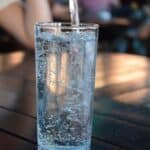This post may contain affiliate links. If you use these links to buy something we may earn a small commission. Thanks.
Ensuring the quality of the water supply you get from your faucet is as good as possible is essential for your and your family’s health. However, you might sometimes notice that your water isn’t running clear; rather, it looks cloudy or milky.
If you notice that you are receiving cloudy water, it is worth investigating to ensure there are no issues.
If you are wondering what causes cloudy water from a faucet, we have everything you need to know right here. This article will look at five of the biggest causes of cloudy or milky water, as well as solutions that can help you resolve them.
What Causes Cloudy Water From a Faucet?
There are many reasons why the drinking water you receive could be cloudy. Taking the time to investigate further will help you find out the cause of the cloudiness and make it easier to find the solutions.
Here are the most common reasons you may have a cloudy water supply.
Air bubbles
Probably the most significant cause of cloudy water is air bubbles. Tiny air bubbles can enter the water stream because of trapped air in your plumbing, plumbing work that has recently been carried out, and an increase in the water pressure for your home’s water supply.
Filling a clean glass from your cold water tap and leaving it for a few seconds will allow the water to settle and become clear again.
Bubbles in your water are completely harmless and safe to drink, but if it persists, you can request your plumber to investigate further.
Hard water
Hard water is water with high mineral content. It is created when water passes through limestone, gypsum, and chalk, which are primarily made up of sulfates, bicarbonates, magnesium carbonates, and calcium.
Hard water is not generally thought to be bad for you. However, it can cause skin irritations or dry out hair when used to wash with.
Other issues that hard water can cause include leaving limescale deposits that can block pipes and boilers and damaging appliances like water heaters, washing machines, and dishwashers.
If this is the issue for you, you should consider getting a kitchen faucet for hard water!
Because of the damage it can cause, and the associated costs, it is possible to install filtration systems to remove the extra minerals, making your water less cloudy. Filtration systems also help to remove chemicals, bacteria, and any sediment that finds its way into your water supply.
Read more: Hard vs Soft Water
Total suspended solids (TSS)
More commonly referred to as TSS, total suspended solids usually happen when construction work, drilling, or other ground disturbances occur near your municipal supply. This result is small particles of silt, sediment, algae, manganese, clay, iron, and other solids floating in your water.
This can lead to bacteria growth in the water if it does not clear, which can be a health risk. Typically, if work has recently been done, the water supply will eventually flush itself clear. If the water supply does not clear up, you should contact your water supplier.
If you live in a more rural area and TSS is a common issue, different levels of filtration systems can be tested to find a solution.
Methane gas
If you find that water sputters from your faucet or contains white air bubbles, it is recommended that you have your supply tested for methane gas.
Because methane gas is flammable, if you have suspicions that your water supply may be contaminated, you can half fill a jug before leaving it to settle. The methane should rise after a few minutes, and you will be able to hold a lit match above it to see if it flares.
Methane gas is an odorless, colorless, tasteless natural gas that can occur naturally. It is most commonly found in well water or rural areas.
It is considered safe to have some methane in your water supply, but you should adhere to the following methane level recommendations:
- Under 10 mg/L of methane found in water is considered safe.
- 10-28 mg/L should be regularly monitored, and you should consider installing a vented well cap.
- Above 28 mg/L is considered too high, and immediate action will have to be taken to reduce the methane levels. An aeration system is one recommendation.
If you have any concerns, you should contact either your local water company or a qualified plumber to investigate further and get the water tested.
Water heater issues
If you find you have cloudy, hot water, you can carry out an experiment to see whether the problem is due to the release of pressurized air or if your water heater needs to be flushed.
Fill a glass from your hot water tap and allow it to settle for a few minutes. Pressurized air in your water clears from the bottom, moving up the glass.
If the water starts to clear from the top with small particles settling at the bottom of the glass, you will have to call a plumber to get your water heater checked as they may have to flush the system to remove sediment or replace the dip tube.
How Do I Fix Cloudy Tap Water?
Several solutions can help diagnose what the issue is and then resolve it.
Filling a glass of water and leaving it is always a great place to start. If there is sediment in your water supply, unlike air bubbles, they won’t clear. You can try a sediment filter that won’t cost much but will usually clear up the issue of cloudy water from a pressurized municipal system.
If you live in a rural area or your water source is from a well, it is advised to get the water tested to ensure it is safe to drink.
It is also worthwhile checking all the faucets to ensure the water is the same from them all. If you only get cloudy tap water from one faucet, you should remove the aerator and clean the aerator using white vinegar before thoroughly rinsing it and reinstalling it to see if this solves the issue.
Final Thoughts
More often than not, cloudy water will be nothing for than tiny air bubbles, but it is always important to check. You should be confident that your tap water is not going to be detrimental to your health.
In most cases, milky, white water is safe to drink. Drinking water that contains more air bubbles than usual is absolutely fine, but you should take the time to check whether other issues are causing the cloudiness.
Carrying out the simple tests outlined in this article should give you a better idea of the cause. If you are still unsure what is making your tap water cloudy, you should get in touch with a qualified plumber or your local water company, who will be able to investigate further.
Other common faucet issues:

